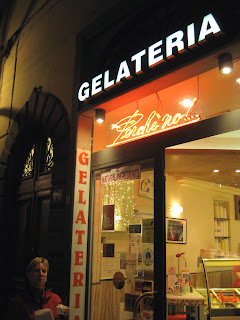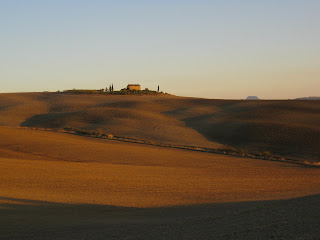These were a surprise to us. I had no idea there were so many thermal bath towns all over Tuscany. We visited two. Not only is San Casciano dei Bagni a beautiful village set in magnificent landscape it also has natural thermal baths nearby. We soaked in the 39 celsius water and enjoyed the water jets and waterfall on a rainy day. I can tell you we were pretty relaxed when we left two hours later. The baths at San Giovanni are much bigger than those at San Casciano with fewer jets and very salty water. It took several days to get the coating of minerals off our skin. I guess I should have showered right after bathing. You should have seen my hair!
The following articles describe Paul and Marielle's trip to Italy (Venice, Tuscany including Florence, and Rome) in October 2010.
Sunday, January 30, 2011
Tuscan Villages
There are big ones and little ones, well known ones and obscure ones, ones on hillsides, ones built on rocky escarpments and fortified ones. Here is a list of the villages we visited in Tuscany. Take your Blue Guide as it will be useful:
San Gimignano for its towers;
Pienza for its pretty location and pecorino cheese;
Montepulciano for its many boutiques and wine cellars with Etruscan ruins and the nearby Tiempo di San Badgio;
San Quirico d’Orcia because it has a great name and leads to the magnificent Val d’Orcia;
Cortona for its pretty location on top of a hill and because of the book, Under a Tuscan Sun, and the steep alleys;
San Casciano dei Bagni for its thermal baths;
Celle sul Rigo for its location and its pici (poor man’s spaghetti) and the flocks of sheep with tinkling bells around their necks;
Radicofani beacuse its stuck on top of a hill with unobstructed views in each direction, a medieval village right on a pilgrimage route;
Pitigliano because its built on a cliff;
Montelupo Fiorentino for its ceramics;
Siena for the campo, the cathedral and many other historic monuments and you can’t go to Tuscany without saying you visited Siena;
Monteriggioni because it is a well preserved fortified town;
Colle Val d’Elsa for its crystal; and,
San Giovanni for its thermal baths.
Passes
If you are budget conscience people like me then you want to save money and optimize your time. One way to do this is to buy passes for transportation and entries into museums and galleries. Most of these passes can be bought online before you go or when you arrive. They are a little more expensive but you won’t have to wait in line.
In Venice as we were staying for a week, we bought the Vaporetto Pass, the Museum Pass, and the Secrets Itinerary pass. You might consider the Chorus Pass as well if you like churches. In Florence we bought passes for the Uffizi and Accademia. In Rome we bought passes for the Vatican Museum (a big time saver), Borghese and Coliseum.
Saturday, January 29, 2011
The Great Flood
On 4th November 1966 after months of higher than usual rainfall the Florentine authorities decided to open a dam on the Arno River to relief pressure without warning their citizens. The resulting flood caked thousands of artistic works with mud and debris, inundated most of the city, submnerged 12,000 cars and claimed up to one hundred lives (although accounts vary). In the Santa Croce area where we were staying the waters reached 22 feet.
 |
| Santa Croce today |
 |
| Santa Croce during the flood |
Gelati
Italian ice cream is one of the culinary wonders of the world. We would stop most afternoons to partake in a little dolce and gelato was often what we chose. I liked all the gelati I tried however connoisseurs rave about two stores in Florence, namely Vivolo and Perche No and San Crispino in Rome. You’ll find their addresses on the Internet.
Remember the Token
If you have travelled to France ignore this article. Remember to take your shopping token with you to Italy. To prevent shoppers from high-jacking the shopping carts supermarkets have a system whereby you have to place your token in the shopping cart to retrieve it from the rest.
Wine in a Plastic Bottle
Until we got up the courage (not feel like an ass) to go to the wine store (see my article on Not all Italians speak English) Marielle and I would buy local wines at the supermarket (4-5 euros the bottle). At the liquor store you come with a clean half litre or litre plastic bottle which the store owner fills from a vat. The variety was good and a litre cost 2 euros. We also got to practice our Italian – un litro di vino rosso locale per favore.
Sarde in Saor
Unless you have a death wish do not try this venetian delicacy. I tried these venetian style sardines in a local restaurant near our apartment. Now remember when you order a fish or meat dish in Italy that is all you get. You have to order the vegetables or pasta apart. Anyway I was confronted with lukewarm, marinated (not cooked) sardines with onions and olive oil and no vegetables to block their taste. The crunchy bones weren’t a lot of fun either. Oh there was a bottle of wine which did help.
Not all Italians Speak English
Many thanks to Chantal for loaning me the Harrap’s Guide to learn Italian which I faithfully followed until the sentences started getting long and complicated. In any case Italians speak English don’t they? The little old lady and old man who stopped us on the Canal bridge in Venice didn’t. The gaz retailer in Chianti didn’t. The taxi drivers in Rome didn’t. Nearly all the shop assistants didn’t and the grocery store owner in Radicofani didn’t. Well actually he did speak French but he let us babble on in halting Italian for thirty minutes before letting us in on his secret. When in Rome do as the romans would do. Try speaking Italian and you will notice how Italians will warm to you. My favourite opening phrases – come si dice … (how do you say?) and parla inglese (do you speak English?). When they reply Non then you ask parla italiano which always brings a smile. Try it, be bold.
Saturday, January 8, 2011
Famous Bridges
The Ponte di Rialto in Venice and the Ponte Vecchio in Florence are examples of multi-purpose bridges. Not only are they used for transportation but they also host a variety of stores.
 |
| Ponte di Rialto Venice |
 |
| Ponte Vecchio Florence |
The current Rialto Bridge was designed by Antonio da Ponte who beat out many more famous people including Michelangelo to get the job. It was completed in 1591. It is always busy here with tourists trying for a photo with nobody else in the background (impossible) or shopping in the boutiques which sell overpriced tourist paraphernalia. Cross the bridge into San Polo sestiere and you will find the same merchandise at lower prices. You also would be entering the market area. From the bridge there are great views in both directions if you manage to elbow your way through the tourists.
 |
| Rialto taken from the Vaporetto stop. Below is a video of the Grand Canal at the Rialto |
The current Ponte Vecchio (literally old bridge) was constructed in 1345. It spans the Arno River which often makes attempts to sweep this bridge away as it has with numerous previous iterations. You will find jewellers, art dealers and souvenir sellers and a great gelato store. The bridge is the best way to get to the Pitti Palace and other North shore attractions. On top of the bridge is the Vasari Corridor, a fortified passage that leads from the Palazzo Vecchio and Uffizi to the Pitti Palace. In less secure times this passage was used by city leaders to flee from attackers. You can go for a walk along the corridor as it is open to the public however according to Rick Steves this is not easy to do. We didn't try it as we were more interested in shopping than sightseeing.
 |
| Gelateria on the Ponte Vecchio |
 |
| Vasari Corridor taken from Uffizi Gallery |
Sunday, January 2, 2011
The Grand Canal
The Grand Canal is the major thoroughfare for water traffic in Venice and there is lots going on. This is a must see and do when you visit. We took vaporetto No.1 which stops at every stop and takes about 45 minutes from Piazza San Marco to Piazzale Roma. Make sure to take it in both directions as in when you arrive at Piazzale Roma hop off and get on the next one making the return journey. No, you can’t stay on the same boat! Be bold and grab a seat outside at the front of the boat to have the best views and photo opportunities. This may take some work as this is prime real estate for tourists however if you use Italian and push in the Americans and Brits will make room. As we travelled the canal on a cloudy (read a big storm is brewing and will drench us soon) day we managed three seats together up front. The trip costs 6 euros 50 one way however by now you have bought your vaporetto pass for the week and it will cost you nothing.
What a spectacle! You will see gondolas full of happy, photo snapping and champagne drinking tourists (90 euros per hour), and traghetti (gondolas that cross the Grand Canal from one side to the other (100 meters for 50 centimes). If you try a traghetto do it standing up as the locals do. I hope you can swim. You will also see water taxis, other vaporetti of all sizes, water ambulances, water police, water hearses, and a variety of barges ferrying goods into Venice and removing waste. I even saw a barge transporting a cement truck to a renovation site. I also heard that some intrepid Canadians had rented kayaks for the journey. That is a death wish! With all this activity (I am sure there are rules) the water gets churned up creating waves and whirlpools.
Lining the banks are numerous palazzi that belonged to wealthy venetian families of the 14th to 16th centuries. In fact most of the members, the men I mean, would often form the parliament running the city (the Doges). Several of these elegant residences now serve as museums. We visited Ca’Rezzonico. If you want to know more about the Grand Canal you will find lots of stuff on the Internet.
I found the Rick Steve’s travel books informative and written for the curious traveller, not for travellers who want to do a thesis on the renaissance. You can download mp3 files and maps from the following site free of charge. You should however buy the books or ask to borrow them from Paul.
Saturday, January 1, 2011
Beautiful Tuscany
The play of light on the barren fields, the cypresses bending in the wind, the storm clouds brewing, the flocks of sheep belles tinkling that produce the famous pecorino cheese, and the organized vineyards marching up the hillsides characterize the Tuscan landscape. Little wonder so many famous artists call this place home. And for amateur photographers even equipped with a cheap point and click opportunities to stop and take a photo present themselves at every bend often to the chagrin of Marielle. Watch out for the cars! I hope you enjoy the following montage.
Subscribe to:
Comments (Atom)


































